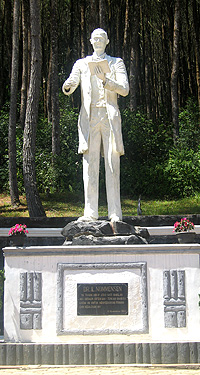Tano Batak Day 3: Porsea - Balige - Tarutung
Departing from Kabupaten Asahan, we entered Kabupaten Tapanuli Utara, a region where Batak Toba people originally came from. This region is situated at the centre of the Province of North Sumatra and contains many small “kampung” (huta) which, some of them, were named after the Bataknese family names who resides in the areas. I bring up the term “Batak Toba” to introduce the fact that there are actually several sub-tribes of Batak such as Toba, Karo, Pakpak, Simalungun, and Mandailing; each has slightly different family names, culture and language.
We started at Porsea, where my mother’s homeland was. It is sometimes confusing when we use the term “homeland” as Batak people mostly tend to migrate. One can say that Porsea is the homeland of the Manurung’s descendants but it does not necessarily mean that the Manurungs had never been elsewhere before. And in addition, it does not, in any way, mean that an area only belongs to one family as many others also resided there. Sitorus, Sirait, and Butar-butar also resides here.
We visited the tomb of my grandfather’s parents from my mother’s side. Our next destination was Balige, we’re heading there simply to check out the tomb of Sisingamangaraja XII. I later found out that Balige is, of course together with several other families, the homeland of Siahaan’s descendants.
Sisingamangaraja XII
 He is regarded as one of the national heroes of Indonesia for his struggle confronting the Dutch invasion to Tapanuli. Legends say that he had some supernatural resistance to fire bullets and by which he could not ever be killed but solely on condition that his hands shall never be desecrated by human blood. The Dutch troops finally revealed his secret and shot his beloved daughter. As expected, he was so devastated by sorrow and sadness that he could not resist to not hug his dear dead covered-with-blood daughter. He was then shot to death by a bullet of the Dutch armies.
He is regarded as one of the national heroes of Indonesia for his struggle confronting the Dutch invasion to Tapanuli. Legends say that he had some supernatural resistance to fire bullets and by which he could not ever be killed but solely on condition that his hands shall never be desecrated by human blood. The Dutch troops finally revealed his secret and shot his beloved daughter. As expected, he was so devastated by sorrow and sadness that he could not resist to not hug his dear dead covered-with-blood daughter. He was then shot to death by a bullet of the Dutch armies.
Afterwards, we headed to Tarutung, the capital district of Kabupaten Tapanuli Utara. Tarutung is the homeland of Hutagalung’s descendants. Tobing, Hutapea, Hutauruk, and Simorangkir also resides here. We visited another tomb in Tarutung, it was the tomb of my grandfather’s parents (and grandparents) from my father’s side. The tombs is situated at the hillside of a mountain, so high we have to walk so far to arrive there (and we ended up having sore feet). Hahaha.
Dr. I. L. Nommensen
 We then visited Salib Kasih, a natural complex built to commemorate the arrival of Nommensen at Tapanuli. Nommensen was a German Christian missionary who came in the. He arrived at Barus and continued his religious mission to Tarutung. Apparently, he was not the first missionary who came for Bataknese people; he was the third, stories say. But none of his predecessors succeeded their mission and in fact they were killed and eaten (legends say).
We then visited Salib Kasih, a natural complex built to commemorate the arrival of Nommensen at Tapanuli. Nommensen was a German Christian missionary who came in the. He arrived at Barus and continued his religious mission to Tarutung. Apparently, he was not the first missionary who came for Bataknese people; he was the third, stories say. But none of his predecessors succeeded their mission and in fact they were killed and eaten (legends say).
Most Bataknese people residing in Tapanuli Utara and Tapanuli Tengah finally converted to Christian from their old tribal religion, Parmalim. Several Bataknese families who resided near Aceh and Padang (northern and southern areas of the Province) converted to Islam, instead.
Everyone is our family and we keep our numbers
As the consequence of keeping our family names, we can always track down our relatives and any inter-relation between several Bataknese families. At least at some point, two people sharing the same family name are of course related to each other (although it will take hours to reveal the links, we love doing this). And even if two people do not share the same family name, one will come up saying that one of his relative does share the same family name and that makes the two person simply a family. This will make one Bataknese person has many ‘additional’ uncles, aunties, siblings, nieces, nephews, and even grandparents. This is practically useful when we’re abroad and have no relative at all. Go search one Bataknese person and we will have one.
In addition to family names, we also have numbers that signify our position in the family tree. For instance, my father is Hutagalung number 14 while I’m Hutagalung number 15. That means my father is the 14th descendant of Raja Hutagalung and I’m the the 15th. My children will be the 16th and my grandchildren will be the 17th. This is essentially useful to find out what we should call somebody sharing the same family name with us if we could not find any direct or indirect familial relation. In many cases, we could.
That’s all for the day. The next day we are going to visit Prapat, Toba Lake, and Samosir Island. I did not expect to know this much about my ancestors and I’m so glad to get the chance to visit my homeland.
